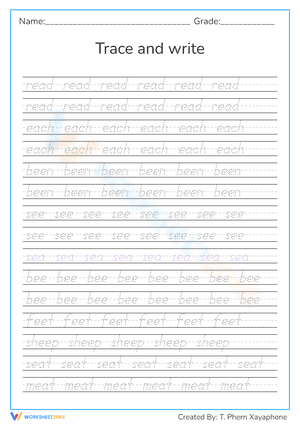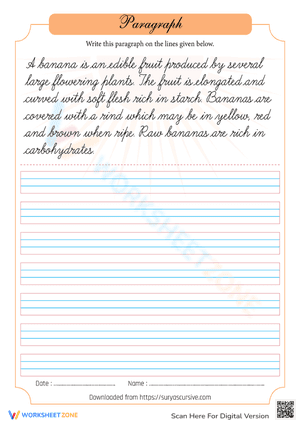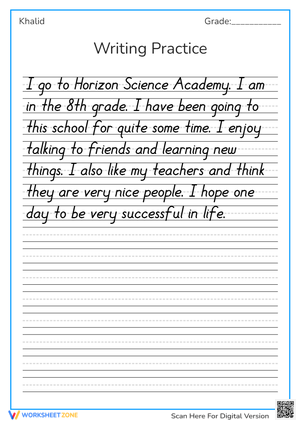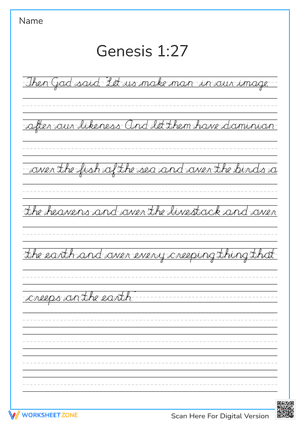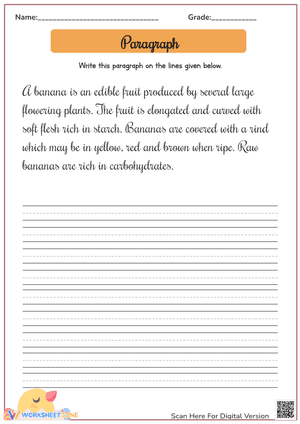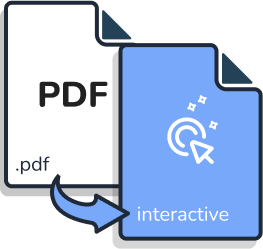After your children have mastered the English alphabet, the next step is to teach them how to write the letters.
It is ideal to teach children cursive handwriting because it offers a more smooth writing style. They may write more quickly as a result. Time is thus effectively saved. These cursive writing worksheets have a lot of pages to help your child learn this writing technique clearly. Your children's writing speed will enhance if you initially trace the letters to help them get used to this writing style. Start by writing letters, then two- and three-letter words, and so on until they reach paragraphs.
Your children's handwriting would be impossible to read without proper writing practice. Keep in mind that bad writing can ruin everything. Youngsters would find it challenging to edit their own work, which would cause them to miss their errors. Let's prevent them from this chance. For free, you may download all of our handwriting worksheets and practice handwriting in cursive.
Although it may not be as common as it once was, cursive writing is a wonderful method for kids to express themselves. Worksheets for practicing cursive handwriting at home are a lot of fun for kids to use as they begin to learn how to write. Moreover, cursive handwriting worksheets can help young students of all ages learn the alphabet and develop better hand-eye coordination.
The majority of children enjoy learning to write their names, which is fantastic because it's one of the skills they should develop the earliest. What better first complete word to master cursive writing?
Tips to Practice Cursive Writing
- Break it up. Start with simply their first name, then go through their last name, then finish with both names together.
- Fewer repetitions. When teaching cursive letters for the first time, keep the number of repeats on each sheet to a minimum. More practice may seem preferable, but for young children, it may be stressful or exhausted. Each cursive worksheet can be adjusted to have 1 to 10 repetitions.
- Use different wording. You can create practice cursive worksheets for other names (such as those of friends and family) or simple words once your youngster has learned their own name. It's a terrific technique to get cursive letter connections down pat!
- Make it more fun. Let the kid choose their favorite border and words to practice. Using a range of tools, such as colored pencils, crayons, and markers, you can practice writing.
What Font Should I Use For Cursive Writing Worksheets?
Selecting a font with arrow guides might be beneficial for children who are still learning how to write by hand so that they can correctly make cursive letters. The dotted font works great after you get the fundamentals down.
We recommend you use the D'Nealian font for well-formed, readable handwriting letters.
Using our available cursive name tracing worksheets to learn hand lettering is another entertaining alternative. To practice hand lettering methods, use a thick marker and a dotted or solid font.
Importance of cursive handwriting
Although many schools no longer actively promote cursive writing, you can still introduce it to your children. Explore why teaching your pupils cursive writing is necessary and what advantages it has.
When teaching handwriting skills to pupils in the past, usually in the second grade, cursive was first introduced. Some private schools start teaching cursive even earlier in kindergarten. Recently, it's no longer part of the common core state standards and is no longer taught in many school systems.
It doesn't stop being significant just because it isn't frequently taught. Your kids will gain a variety of advantages from cursive writing if they practice regularly and master legible cursive.
Why is learning cursive writing important?
Cursive writing is crucial for brain development. You use many parts of the brain that process information and store it in memory when you write in cursive. Cursive writing primes the brain for the best possible learning environment, according to research.
Because it doesn't involve the same fine motor skills while also engaging your intellect, typing just doesn't have the same effect on the brain.
Cursive writing and reading
Your youngster will learn to read in cursive once they can write it. Cursive writing can be found on numerous significant historical documents and antique letters. Would you be able to read one of these pages if you were handed this without a computer or other technology? How about some old letters you got in a box on your grandparents' roof?
The most significant writings of the Founding Fathers were written in cursive, which plays a significant role in history. We should learn cursive so that we can read and understand history.
Benefits of Cursive Writing
The art of writing in cursive is more than just neat, polished handwriting. When your kids learn to write in cursive, they truly gain a lot of advantages.
- Enhance fine motor skills. Your youngster needs to be able to hold the pencil properly and tilt the paper when learning how to write in cursive. They must exert just the appropriate amount of force to smoothly glide their pencil across the page without taking it off in order to write the letters and join the cursive letters.
- Activates the brain's neuronal pathways. The brain is activated and stimulated in some astonishing ways when you actually use a pen or pencil on paper. Since everything is active at once, it essentially primes the brain and creates the best learning environment.
- Develops discipline. Cursive writing requires determination and practice. It is gratifying to put in a lot of practice and eventually produce lovely handwriting. Writing and taking joy in your work foster discipline and excellent habits. Cursive-writing students have been found to be more academically inclined and well-organized.
- Promotes grammar and spelling. Because writing in cursive involves the brain, it encourages your child to slow down and read what they are writing rather than merely duplicating it. According to studies, actively writing in cursive is a key strategy for mastering proper grammar and spelling.
- Helps with learning disabilities. Print letters can fool kids with dyslexia since they resemble one other so much. Children with dyslexia and dysgraphia may find it easier to focus when writing and to avoid confusion thanks to the distinctive appearance of cursive writing. For pupils with disabilities, flowing letters are simpler than stick and circle forms. It virtually eliminates letter ambiguity.
Why do we need cursive writing worksheets?
Writing in cursive is meant to allow you to write far more quickly than you can when printing. You can write considerably more quickly since the letters are joined in a smooth manner. For each row of the letters, you don't need to remove your pencil from the paper.
Cursive is Excellent for Taking Notes
When you don't have a computer or a phone with you, cursive is excellent for taking notes rapidly. When writing in cursive, you can write more quickly while someone is speaking.
Cursive Appearances More Expert
Cursive writing, which was commonly taught in business schools, was employed to make handwriting appear polished, attractive, and sophisticated. In the days before computers, it was not only a very effective technique to enter data in ledgers and accounting notebooks, but it also had a professional appearance. Things could be quickly recorded, and it also looked good.
Cursive Signatures
Writing your name in cursive results in a distinctive signature that is unique to you. A distinctive signature is made using cursive writing. The need for a real signature still exists despite the abundance of technologies at our disposal. It will be challenging for your child to develop a signature to sign their name with if they are unable to write in cursive.
Is cursive really necessary?
Given that we live in a digital age, it doesn't seem like we need to write more quickly in the modern world. Almost everyone uses a variety of electronic devices to communicate.
The days of writing letters are long gone. Many signatures, according to some, are created digitally. Many people might not believe that cursive is necessary as a result of these changes to the educational system.
Fortunately, many parents still think it is important and relevant today. Even today, a lot of parents and educators decide to teach it to their kids. For whatever justification there is for not teaching cursive, there are an equal number of justifications for doing so.
The advantages of cursive writing for young children
Beginning to write by hand at a young age has several advantages. Even just learning how to hold your paper and pencil properly can help young children develop their fine motor skills, hand-eye coordination, and cognitive development.
Less different stroke types are needed to make letters in cursive writing. It also gets rid of letter ambiguity. Because of this, several private schools decide to start teaching cursive to first-graders.
Cursive writing stimulates the brain, accelerating learning and memory retention for your youngster. Because kids must consider each hand movement they make when writing, it fosters critical thinking abilities.
Making Students Successful
Early exposure to cursive writing prepares students for success in other types of writing and reading. It is similar to acquiring a second language and getting their brains ready for reading.
Your youngster will read full words rather than letters at a time with the help of cursive writing. Instead of printing one letter at a time to create a word, people who write in cursive write the entire word at once. Their brain can rapidly detect the term and read it without even hearing out the letters because the letters are all connected.
Science Behind Cursive Writing
Cursive writing has been demonstrated to stimulate the brain regions that control memory and information coding. When using a keyboard or typewriter, certain areas of the brain are not stimulated in the same way.
Cursive handwriting prepares the brain for learning by synchronizing brain synapses and engaging the parietal lobe and central regions of the brain, according to a number of studies and data analysis. These sections of the brain are in charge of memory and encoding newly acquired information.
In one such study, researchers contrasted children learning handwriting with those who were just engaging in verbal and oral learning by examining their brain scans. The children who were writing by hand displayed brain activation that was comparable to an adult's after 4 weeks. The advantages of writing by hand are enhanced by letter recognition, which helps people learn to read more quickly, according to the same study.
Cursive Writing: A History
Cursive writing styles were utilized by the Romans and Greeks to construct contracts, letters, and other written materials. In the Middle Ages, Europeans began writing Latin in cursive after being influenced by Arabs who used a particular style of writing.
In the 1700s and 1800s, quill writing became increasingly widespread in England and the United States once it was invented for writing. Europe gave rise to the style of cursive known as "Round Hand." Copper plates were used in the printing of the copybooks that students use. Because of this, Round Hand was sometimes known as Copperplate writing.
The Declaration of Independence was written in Round Hand, a type of writing that was specifically created for use with a quill pen, in copperplate.
Why Cursive Should Be Taught in Your Homeschool
- Printing takes longer than this. Once they are proficient, your children can take notes like a pro.
- Cursive is incredibly attractive and looks great when writing in notebooks and letters.
- Cursive writing works every area of the brain simultaneously and can even improve concentration and focus in dyslexic children.
- Your child will learn to write in cursive, which also improves their language and memory skills and aids in information retention.
- Your youngster will read more quickly and comprehend the English language with the aid of cursive.
- It promotes good writing habits and neatness in children and encourages them to take pride in their work.
- It also helps to establish a signature when writing your own name in cursive. Documents still require written signatures, which must be individualized and particular to the owner.
- Being able to write and read cursive allows you to read letters and old documents that have been written in the style.
- Cursive is an art form. Once you master cursive, you can advance to calligraphy, creative lettering, and even graphic design. It is a lovely and practical talent.
- Because cursive writing is a part of history, it is crucial to preserve it now before it disappears altogether one day.
Our Cursive worksheets
Do you formally instruct your kids in cursive writing? Do they require further assistance with cursive writing practice? Numerous cursive worksheets for writing are available in Worksheetzone to help you improve your kid’s handwriting.
